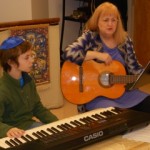What is a Leap Year?
This year is a leap year in the Jewish calendar. As educators, an extra month before Purim is a great breather. It gives us some more space to teach in between the holidays that come rapidly at this time of year. Having two Adars brings much joy to our lives, since it stated in the Talmud: “When Adar comes, be happy”(Mishenichnas Adar marbin b’simcha!). So, we are commended to be happy this year for two months instead of one. Why not? It definitely can’t hurt.
Here is some information regarding the leap year:
The people of Israel were given two different commandments that contradict each other: To use the lunar calendar and to celebrate Passover in the spring. If we use only the lunar calendar, the holiday of Pesach won’t always fall in the spring and that will cause us a problem with the second commandment. In order to fulfill both of these commandments, the Rabbis added a 13th month to a year every few years. On a leap year we have two Adars (Adar 1 and Adar 2), to make sure that when Nisan comes (the month of Pesach) it will be springtime.
The Jewish “leap year”, which occurs seven times in a 19-year cycle, has 13 months instead of the regular year’s 12. This is so that the lunar-based Jewish year should remain aligned with the solar seasons (12 lunar months make up a total of 354 days — slightly more than 11 days short of the 365.25 day solar cycle).
An interesting fact to know is that the Muslims use only the lunar calendar and this is the reason for the change of the seasons of which their holidays fall on. Their holidays don’t connect to the seasons like the Jewish calendar. For example, when they have the month of the Ramadan in the summer, it is much harder to fast for a month rather than when it is fall in the winter. As Jews, our calendar is strongly connected to the agriculture and the seasons. Can you picture sitting in the Sukkah in the middle of winter, or gathering the harvest in the spring, before the crops are ripe and ready to be picked? It just won’t work!
To determine whether a Jewish year is a leap year, one must find its position in the 19-year Metonic cycle. This position is calculated by dividing the Jewish year number by 19 and finding the remainder. For example, Jewish year 5771 divided by 19 results in a remainder of 14, indicating that it is year 14 of the Metonic cycle. Since there is no year 0, a remainder of 0 indicates that the year is year 19 of the cycle. (See also Golden number (time).) Years 3, 6, 8, 11, 14, 17, and 19 the Metonic cycle are leap years.
Now, that you know all about the leap year, you understand that this year you have more time to prepare your costume for Purim. So, get to work! We would love to see some fun costumes on 3/15.
Getting Ready for Chanukah
This gallery contains 11 photos.
Na’ama Yarden












